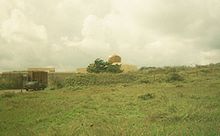From Wikipedia, the free encyclopedia
(Redirected from Sufi Movement)
| This article needs additional citations for verification. (August 2012) |
For other uses, see Inayat Khan (disambiguation).
Inayat Khan (Urdu: عنایت خان ) (July 5, 1882 – February 5, 1927) was the founder of The Sufi Order in the West in 1914 (London) and teacher of Universal Sufism. He initially came to the West as a Northern Indian classical musician, having received the honorific "Tansen" from the Nizam of Hyderabad, but he soon turned to the introduction and transmission of Sufi thought and practice. Later, in 1923, the Sufi Order of the London period was dissolved into a new organization, formed under Swiss law, called the "International Sufi Movement". His message of divine unity (Tawhid) focused on the themes of love, harmony and beauty. He taught that blind adherence to any book rendered religion void of spirit. Branches of Inayat Khan's movement can be found in the Netherlands, France, England, Germany, the United States, Canada, Russia and Australia.Contents[hide] |
[edit] Life
Inayat Khan was born in Vadodara, Gujarat to a noble Muslim Indian family (his mother was a descendant of the uncle of Tipu Sultan, the famous eighteenth century ruler of Mysore). Primarily he represented the Chishti Order of Sufism, having received initiation into the Nizamiyya sub-branch of that order from Shaykh Muhammed Abu Hashim Madani, but was also initiated into the Suhrawardiyya, Qadiriyya and Naqshbandi. His spiritual lineage (Silsila), as compiled by Pir Zia Inayat Khan,[1] follows a traditional lineage from Ali ibn Abi Talib, through Abu Ishaq Shami (d. 940), the founder of the Chishti order, to Nasiruddin Chiragh Dehlavi (d. 1356).With the Shaykh's encouragement he left India in 1910 to come to the West, traveling first as a touring musician and then as a teacher of Sufism, visiting three continents. Eventually he married Ora Ray Baker (Pirani Ameena Begum), from New Mexico, and they had had four children; Noor-un-Nisa (1914), Vilayat (1916), Hidayat (1917) and Khair-un-Nisa (1919). The family settled in Suresnes near Paris.
In 1922, during a summer school, Inayat Khan had a spiritual experience in the South Dunes in Katwijk, The Netherlands. He immediately told his students to meditate and proclaimed the place holy. In 1969 the Universal Sufi Temple was built there. Khan returned to India at the end of 1926 and there chose the site of his tomb, the Nizamuddin Dargah complex in Delhi where the founder of the Nizami Chishtiyya, Shaykh Nizamuddin Auliya (died 1325), is buried. Khan died shortly after, on February 5, 1927.
[edit] Foundational principles
Inayat Khan set forth ten principles that formed the foundational principles of his Universal Sufism:[2]- There is one God; the Eternal, the Only Being; None exists save He.
- There is one master; the guiding spirit of all souls that constantly leads all followers toward the light.
- There is one holy book; the sacred manuscript of nature, the only Scripture that can enlighten the reader.
- There is one religion; unswerving progress in the right direction toward the Ideal, which fulfills every soul's life purpose.
- There is one law; the law of reciprocity, which can be observed by a selfless conscience, together with a sense of awakened justice.
- There is one brotherhood; the human brotherhood which unites the children of earth indiscriminately in the fatherhood of God. This was later adapted by followers to; "There is one Family, the Human Family, which unites the Children of Earth indiscriminately in the Parenthood of God."
- There is one moral; the love which springs forth from self-denial and blooms in deeds of beneficence. ... (later alternative; "which springs forth from a willing heart, surrendered in service to God and Humanity, and which blooms in deeds of beneficence").
- There is one object of praise; the beauty which uplifts the heart of its worshipper through all aspects from the seen to the unseen.
- There is one truth; true knowledge of our being, within and without, which is the essence of Wisdom.
- There is one path; annihilation of the false ego in the real (later alternative; "the effacement of the limited self in the Unlimited"), which raises the mortal to immortality, in which resides all perfection.
[edit] Music
- Song "Yaman Kalyan Khyal" by Inayat Khan recorded in Calcutta 1909
- «Hindustani songs by prof. Inayat Khan» 16 melodies for piano (1915). Performed by Philip Sear
- «Hindustani songs by prof. Inayat Khan» (scores PDF)
[edit] References
- ^ Silsila / Shajara – The Chain of Spiritual Transmission
- ^ In The Spiritual Message of Inayat Khan, Volume I – The Way of Illumination, VOLUME I – I – 1 at wahiduddin.net
- ^ Carl Ernst and Bruce Lawrence, Sufi Martyrs of Love, New York: Palgrave Macmillan, 2002, p.142. ISBN 1-4039-6027-5.

No comments:
Post a Comment